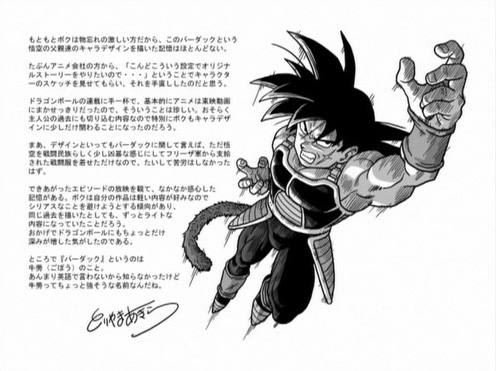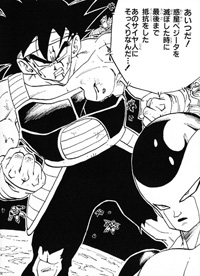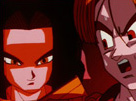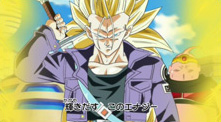From 2003 to 2006, Toei Animation released the Dragon Box DVD sets in Japan, collecting all of the franchise’s TV episodes, specials, and movies on a home release for the first time ever in their home country — while the movies had previously been released on VHS and Laserdisc, this was the first time for everything else. Following their respective box sets, individual discs were released over the course of 2005 to 2009. The Bardock and Trunks TV specials — which were included as “extras” on the two Dragon Ball Z Dragon Box sets — did not receive individual disc releases.
In early 2007, Shueisha posted a final update to its DVD blog hinting that these specials might possibly see a DVD release, but unfortunately, nothing ever came of that. The movies completed their individual discs in 2009, and Japan promptly moved on to Dragon Ball Kai.
At that point, fans were left to believe that the TV specials, widely considered some of the best material to come out of Toei in terms of original creations for the franchise, would be forever stuck in the expensive DVD sets. It came as a minor shock that Shueisha announced a budget-priced DVD release with both specials on the same disc for release on 05 August 2011 (titled the Dragon Ball Z Special Selection DVD), tying in with and cross-promoting what would become Episode of Bardock, a new, three-part, spin-off manga created by Naho Ooishi. Bardock was suddenly receiving the spotlight all over again, and Trunks was along for the ride this time.
Quick Details:
| ISBN: | 978-4-08-908141-9 |
| Publisher: | Shueisha |
| Release Date: | 05 August 2011 |
| MSRP: | ¥1,000 |
| Format: | DVD (Region 2) |
| Contents: | Bardock & Trunks Dragon Ball Z TV Specials |
The review of this DVD was made possible by your referral purchases on CDJapan. If you are interested in contributing to the site, please visit our “Donate” page.
Review By: Mike LaBrie (VegettoEX)
Coming as a budget release two years after the rest of its comrades, does this single-disc deliver on the content side, and how does its presentation hold up compared to prior releases?
Content:
Originally airing on 17 October 1990 and 24 February 1993, fans have had plenty of time to discuss and analyze both the Bardock and Trunks TV specials, respectively. Particularly for North American fans who have seen a DVD release three times over (several of them moderately-budget-priced, themselves), the content generally needs no further introduction. For the sake of completion, we will at least detail the major points of each special, but will hold back on a full analysis. Those interested in hearing more might want to check out episodes #0213 (comparison and review of the original manga chapters of “TRUNKS: THE STORY” versus its TV special adaptation) and #0187 (review of the Bardock TV special) of our weekly podcast.
Bardock TV Special:
たったひとりの最終決戦 ~フリーザに挑んだZ戦士孫悟空の父~
Tatta Hitori no Saishû Kessen ~Furîza ni Idonda Z Senshi Kakarotto no Chichi~
A Lonesome, Final Battle: The Father of Z-Warrior Kakarrot, who Challenged Freeza

On Planet Vegeta, a Saiyan baby named “Kakarrot” has been born. On another planet, his father Bardock and his teammates are destroying the population as Ôzaru. After seemingly completing their mission, Bardock is attacked by one of the inhabitants who afflicts him with the curse of premonition before being killed by Bardock’s teammate. Bardock collapses and is brought back to health, but not before seeing strange future visions. Bardock’s team has already taken off for their next mission, so he grabs his scouter and takes off with a smile… but not before coming across his baby son and scoffing at how low a battle power he has. Bardock arrives on Planet Meat to find his entire team wiped out by Dodoria and his own team of henchmen. Bardock fights back, but is ultimately blasted to near-death by Dodoria. Bardock somehow makes his way back in his space pod (passing his son’s along the way, who has been launched to destroy a planet called “Earth”) to attempt to warn his fellow Saiyans — Freeza is planning to wipe out their entire race! Bardock is, unfortunately, met with laughter.
Bardock decides to take fate into his own hands and flies off to challenge Freeza. The evil tyrant calms his increasing rage and pops out of his ship to meet the Saiyan face-to-face. Bardock claims that he will alter everyone’s fate: his own, his son’s, and Freeza’s. Claiming it to be the end for Freeza, Bardock launches a blast which is met by one of Freeza’s own. The giant blast engulfs and negates Bardock’s own, and flies onward to seemingly obliterate Bardock as it heads toward Planet Vegeta. As Bardock falls into the blast, he has one final vision: his son, now a grown man, will challenge Freeza. Planet Vegeta and the entire rest of the Saiyan race is destroyed, save for just few: the prince, Vegeta, is off on another planet communicating with another Saiyan named Nappa, and Kakarrot has landed on Earth, only to be found by a kind old man that names the strange, tailed boy “Son Goku”.
As extensively documented on our Bardock “Tidbit” page, this particular TV special had a fascinating development. Supervised and produced by franchise veterans such as Takao Koyama with designs by equally-veteran artists Minoru Maeda and Katsuyoshi Nakatsuru, the original story fleshes out what manga author Akira Toriyama only managed to hint at from time to time in the original story.
What perhaps makes this TV special so interesting is its incorporation back into the manga. Speaking in a prior daizenshuu interview (and later repeated almost verbatim in a special message on this very DVD), Toriyama notes how that it was a “pretty dramatic story that I’d never draw myself”, and that he therefore had a chance to see a different version of his own series “in a good way”. It apparently made quite an impression on the author, as he actually incorporated its story back into the manga for two panels in Chapter 307:
It is indeed quite a different type of story than Toriyama had been writing up to this point, but not so far off the beaten path that it feels out-of-place or somehow unrecognizable. The TV special is a fantastic addition to the universe, particularly when viewed at the point that it was produced — a good deal of emotional impact would be lost on the viewer if viewed “chronologically” (that is to say, before the rest of the entire series that takes place “after” it), which is why its inclusion at the very beginning of Dragon Ball Kai never really made all that much sense.
Trunks TV Special:
絶望への反抗!!残された超戦士・悟飯とトランクス
Zetsubô e no Hankô!! Nokosareta Chô-Senshi • Gohan to Torankusu
Resistance to Despair!! The Remaining Super-Warriors, Gohan and Trunks

In a time different from the one we have thus far followed over the course of the series, Goku has died from a heart disease. Some time later, a pair of Artificial Humans (#17 and #18, created by Dr. Gero) have begun to wreak havoc on the planet. Most of Earth’s heroes have been killed (Piccolo, Vegeta, Yamcha, Tenshinhan, and Kuririn). With no real obstacles in their way, the Artificial Humans move from city to city destroying all in their path. Gohan is still alive, however, and occasionally shows up to stop them as best he can! Gohan and a young Trunks are all that Earth have left. Trunks cannot stand how weak he is, and asks Gohan to formally train him to help defend the Earth. It will be difficult, but Trunks will give it his all. Unfortunately, Trunks is still unable to transform into a Super Saiyan. The Artificial Humans attack another city, so the duo will head to defend them. Gohan fights back well enough, but loses an arm in the process of battling and saving Trunks before the Artificial Humans take off. The two heal up and continue their training. The Artificial Humans begin an assault on yet another town, and so the two prepare for battle. At the last second, however, Gohan chops Trunks unconscious, saying that he is all Earth has left and he must remain safe. Gohan flies off to battle them alone, and is killed. Trunks wakes up and flies off to find his master and friend lying dead face-down in a puddle. The anger and loss finally pushes Trunks over the edge into a Super Saiyan.
Some years have passed, and Bulma is working on the time machine to allow Trunks to visit the past and change this horrible future for the better — if only Goku were alive, this could all have been avoided! The Artificial Humans are on the move again, though, so Trunks decides that with his new power he may be able to take them out for good. Trunks arrives, but is made quick work of, even as a Super Saiyan with a sword — after a thorough beating, the Artificial Humans leave Trunks for dead. A few days later, Trunks wakes up under the care of his mother. The time machine is ready to go (and they write the word “HOPE!!” on its side to signify their goal), so Trunks takes off to alter history!
The Trunks TV special is a sort of flip-flop situation from the Bardock TV special — whereas Bardock’s story was created for the anime and then retroactively applied to the manga, this story was first written for the manga (an un-numbered chapter entitled “TRUNKS: THE STORY” originally published alongside Chapter 386 in Weekly Shônen Jump in August 1992) and then adapted for TV.
It also has the distinction of having one of the only instances where an event in the manga is heavily altered in terms of raw storytelling for its TV adaptation. In Toriyama’s original manga chapters, Trunks is already a Super Saiyan. In the TV version, this transformation is shown to be a huge struggle for the character, and is not actually obtained until prompted by Gohan’s death.
This special, much like the Bardock one from years prior, is another example of extremely serious storytelling (at least comparatively so for this franchise), though one with groundwork laid by the original author. The drama is played up to a larger degree, with framing and direction techniques used in ways that the regular TV series had never seen.
Presentation:
The Special Selection DVD presents both TV specials with the same audio and video masters from the Dragon Box versions nearly eight years prior — that is to say, the best they have ever been presented on a home format. While not on the same level as the theatrical films, the TV specials received higher-budget productions than the standard TV episodes. Having amazing staff such as Masako Satô common to each certainly bumped up the visuals in areas like clarity and consistency. The production values still shine through to this day.
The footage is near-identical to the Dragon Box release from 2003, with just a couple incredibly minor differences: slightly sharper footage, and a (mostly) lack of black buffer area around the video.
The sharpness on the new encode will not be apparent to anyone who is not purposefully tossing them side-by-side and actively looking for any difference. It does seem to be sharper footage, though, as opposed to differences in video noise from encoding methods. Areas where it will be noticeable at all will be places like the below example on Bardock’s scouter, where the eye behind it comes into focus in the new Special Selection DVD a tad bit more than it did on the Dragon Box. You will need to squint, and you will need to inch yourself closer to the screen, but it is there.

Back on the Dragon Box version of the specials, many scenes would have a slight black border on the left and right side of the screen — it was inconsistent from scene to scene, but would generally not be noticed unless viewed on a computer or pixel-for-pixel screen due to overscan. With the exception of possibly one scene throughout the entire two specials, this border is completely removed to reveal the full amount of pixels underneath. It is interesting that despite having the exact same framing as the Dragon Box versions, this new Special Selection DVD manages to bump things up a notch, even if in these barely-noticeable ways.

The new video encode hovers around the 5 to 6 Mbps mark, which is a dip from the excessive 8 Mbps range of the Dragon Box encodes, but you will never notice the difference. The TV specials are still a proper 4:3 and progressive film. The first set of extras (production sketches) are also 4:3, while the second set of extras (Dragon Ball Heroes promos) are widescreen and interlaced.
On the audio side, things are bumped down from a 448 kbps encode on the Dragon Box to a modest 192 kbps encode on the Special Selection DVD. This makes sense as there are now two full-length specials on the same disc (as opposed to just the one, or one plus extras). Again, you will be hard-pressed to hear any difference.
The Special Selection DVD retains all of the eyecatches and preview spots for the TV specials, though the previews have been moved from before the features (as on the Dragon Box extra discs) to immediately following them. There are no subtitles for any language on this Japanese release.
Packaging:
The Special Selection DVD comes in unique packaging for the franchise. This type of budget release, often seen in Japanese convenience stores, is packaged in a larger, cardboard frame which holds the DVD inside. The artwork continues onto this frame, providing more room for branding and promotion. The full packaging is roughly 8.25 inches by 11.625 inches, though the DVD case inside is the standard thickness amaray case. It might be worth noting that early artwork for the packaging had “Heroes” spelled incorrectly as “Heros” in the upper-left, but this was fixed for the final release.
The back of the DVD case is very similar to the back of the larger cardboard packaging, just with a few things rearranged toward the bottom:
Inside the DVD case is the disc itself and two Dragon Ball Heroes cards wrapped in plastic (along with an extra, thin piece of paper the same size as the cards that explains how to use them for the arcade game).
The packaging had some extra heft to it with the cardboard and the cards, but the real meat comes via on-disc extras.
The Extra Stuff:
Surprisingly, this budget release comes with two bonus inclusions: a series of production sketches and designs from the TV specials themselves, and a series of Dragon Ball Heroes promotional videos.
The production sketches are introduced with a statement from Akira Toriyama, the original author himself (as well as his own, new sketch of Bardock). As noted earlier, he amusingly states almost the exact same feelings about the specials as he did so many years earlier. Regardless, it is always fantastic to hear his viewpoint, since it is one that as fans we can only otherwise imagine.

I’m always forgetting things to begin with, so I have almost no memory of drawing the character design for Goku’s father Bardock and co.
I think what probably happened was, somebody from the animation company came to me and said, ‘we’d like to an original story based on these designs…’ and when I had them show me the sketches, I ended up redoing them.
I had my hands full just with Dragon Ball’s manga serialization, and I basically left the anime up to Toei Animation, so that sort of situation was rare. Perhaps it was because the content impinged upon the past of the main character that I was specially called upon to be involved a little bit with the character designs.
Well, even calling it a ‘design’, with regards to Bardock, all I really did was take Goku and give him the brutal edge of a warrior race, and dress him in the battle armor provided by Freeza’s forces, so I can’t have gone to too much trouble.
When I saw the finished episode, I remember feeling a good bit of admiration. With my works, I prefer lighthearted fare, so I have a tendency to avoid serious material. Even if I had written about the same past, it would have become lighter in tone by far. Thanks to this, I felt as though even Dragon Ball had been given a little bit more depth.
By the way, ‘Bardock’ refers to burdock [in Japanese, ‘gobô’]. I didn’t realize it, not usually saying it in English, but ‘burdock’ is a pretty strong-sounding name, isn’t it?
AKIRA TORIYAMA
The first section of the production sketches video showcases only previously-published character designs, such as Katsuyoshi Nakatsuru’s original design for Bardock (first shown in 2003’s TV anime guide book Dragon Ball Z: Son Gokū Densetsu), along with other designs from the sixth daizenshuu (“MOVIES & TV SPECIALS”). The video quality from the TV special looks extremely zoomed-in for certain characters, but it becomes clear that this is done for a reason — to the best of the editor’s ability, screens from the TV series are placed and transitioned over top their respective sketches.

The section with Trunks TV special materials is where longtime fans will really take notice. As opposed to the Bardock section full of previously-released materials, we are privy to a nice selection of never-before-seen sketches of both characters and backgrounds. Of particular note is a reference sketch of a younger Trunks seemingly becoming a Super Saiyan for the first time, which was later adapted by Minoru Maeda for the third “side story” published in the Jump Anime Comics version of the Bardock TV special:
The video continues on to show sketches that are entirely new to us, though! There is a good bit of technology shown off (air cars), different locations (Capsule Corp., the amusement park), and even a few cel sketches of the characters (#18).
The music playing throughout the video in the background seems a little out of place, but the visual content more than makes up for it.
Dragon Ball Heroes, the latest card-based arcade game for the franchise in Japan, has seen plenty of updates over the last year. Some of its recent additions include Slug and his minions (from the fourth Dragon Ball Z movie), as well as a tie-in with the special Episode of Bardock three-part spin-off manga published in V-Jump over the course of August, September, and October 2011. In the story, constructed as a “sequel” to the TV special that spawned the character, Bardock is transported 1,000 years into the past after his attack on Freeza and ultimately becomes the original Super Saiyan of legend. Many of these arcade game updates received promotional videos with new animation; branded with the Dragon Ball Heroes name on its packaging, it made sense to include some of this video as bonus content.
The DVD features five videos: one (approximately two-and-a-half minute) general promotional/overview video, and four update-specific videos that tell a little story via new 2D animation. Throughout all of the promotional videos, the game’s theme song plays in the background (performed by “Dragon Soul”, the same as the opening theme to Dragon Ball Kai).
The overview video provides a look at the game play for Dragon Ball Heroes, something many fans outside of Japan rarely get a glimpse at. All of the various updates and character inclusions are given a brief cameo, as well.
The first standard promotional video included is the first one released for Dragon Ball Heroes, showcasing the “Hero” character captured into the world of the game to fight alongside Goku and some of the other types of character (Berserker and Elite) against Cell and the Cell Jrs.
The second promotional video showcases the Majin Boo update which also includes a Super Saiyan 3 transformation for Trunks. Boo changes a group of humans into candy and attempts to eat them, but the Majin “Hero”-type, the player, and Super Saiyan 3 Trunks fight back to rescue them.
The third promotional video introduces the female player protagonist design as well as Freeza and his henchmen. The player characters attack the various henchmen until Freeza intervenes, but Goku saves the day and the group triumphs over evil together.
The fourth and final promotional video introduces Slug and his henchmen (from the fourth Dragon Ball Z movie), as well as the “Hero”-type character from Freeza’s race, who seemingly joins the player character and Goku to save an alien race from Slug’s destruction.
It is fantastic to finally have these promotional videos, previously streamed online, in an archival format at a decent resolution. They almost act as these short, minute-long “movies” with a clear introduction, climax, and conclusion to each. In that way they are exciting, but they also leave us salivating a tad bit for more. The character designs range from wonderfully-detailed to slightly off-model (such as Goku each time he is shown), but that is to be expected after such a long time and characters shifting through so many artists’ hands.
Final Thoughts:
This is easily one of the most no-brainers in recent history. For a ridiculous ¥1000 (around $12-13 at the time of its release), we get two TV specials with near-impeccable presentation on the same disc along with two bonus videos that collect new and old material alike. This disc easily could have been released for the standard ¥2800 that the movies went for, and those all came out as a single movie per disc — this disc has the two specials and two wonderful extra videos sequences.
Shueisha really did a bang-up job with this release. Those who missed out on the Dragon Box sets and have been looking to plug a few holes in their R2 DVD collection (or even international fans looking for the specials in the best version possible) no longer have any reason to cry! History has been changed for the better! Will it have any unintended consequences, though? Only more time will tell…
Purchase This Item:
The Dragon Ball Z Special Selection DVD may be available at the following online retailers:































